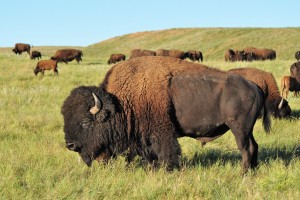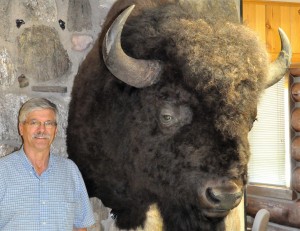Photography courtesy of Lowell Washburn, all rights reserved.
Viewing Can Become A Dangerous Obsession
The American bison is the largest land animal in the western hemisphere. I’ve never heard of anyone who didn’t find the giant prairie icons fascinating, and some ‘buffalo watchers’ enjoy the creatures to the point of obsession. I fall into the latter category. When it comes to bison, I can never ever get enough viewing. Given the chance, I can literally sit and watch them from sunrise to sunset, day after day after day.
One of my favorite viewing areas is located in western South Dakota’s Custer State Park where a 71,000 acre mix of ponderosa pine and open prairie are more than enough to provide the illusion of free range. I first laid an eyeball on the Custer herd when my parents brought me here in 1958. I’ve been returning ever since.
Early September is a prime time to visit the Black Hills. By now, the noise and congestion of the annual Sturgis motorcycle rally is nearly forgotten. On the sidewalk racks of Hill City, brand new 2016 Rally T-shirts can be had for three bucks; cheap enough to use for paint rags. Better still, the carnival-like atmosphere of the Hill’s next big event – Custer’s Annual Buffalo Roundup — is still weeks in the offing. For now at least, tranquility reigns supreme. The sound of gasoline engines has been replaced by the whisper of pines and the deep guttural roaring of mature bison bulls.
Bison can be as deceiving as they are interesting. Most people realize buffalo are large, they just don’t realize how large. Big boned and unimaginably solid, a mature bull is a locomotive on legs. By the time a bull reaches five years of age, he may stand more than six feet at the shoulder and weigh in excess of a ton. Some folks will tell you that bulls don’t really get that large, but they do. On a paved road inside Custer Park, a mature bull wandered into the path of an oncoming four-wheel-drive pickup. The driver survived. The bull and truck did not. The bison’s carcass weighed in at 2,200 pounds; its’ head now hangs on a stone fireplace at the park’s Game & Fish Headquarters. Stand next to that head, and you will get a true feel for just how massive these animals can become. It’s also the only safe way to obtain a really close up view of an American bison.
Although grazing bison may appear as docile as Elsie the Cow, they remain potentially dangerous. Even in the heart of Tourist Country, bison are still wildlife. They may be conditioned to seeing people wearing colorful Bermuda shorts and funny hats, but they are not tame. When incited to riot, these not-so-gentle giants can move with cat-like agility and the consequences can be dire. In spite of numerous warning signs, people continue to invade the ‘personal space’ of loafing bison. Sometimes they get away with it; sometimes they don’t. Earlier this season, a 50-year-old woman from Missouri approached a 5-year-old bull for a close up photo with her I-phone. The bull objected, charged and sent her flying. Fortunately for the photographer, the bull decided to let it go at that. The severely injured woman was life-flighted to Rapid City where, although listed in serious condition, she was expected to recover.
It should be noted that incidents like that are pleasantly uncommon. When it comes to bison, humans usually have the last word. Travel through South Dakota and you won’t hardly find a restaurant or pop stand that doesn’t try to sell you a “Buffalo Burger”, not to mention bison roasts, sausage, ‘brats and bacon. Once you’ve sampled all that, you can go up to the Sylvan Lake Lodge and enjoy an incredible Dances with Wolves platter of buffalo ribs or treat yourself to a thick bison ribeye that is to die for – and then some. I try to eat some form of bison every day that I’m in Dakota. Like buffalo watching, I can never ever get enough.




 Tom Cope
Tom Cope Sue Wilkinson
Sue Wilkinson Susan Judkins Josten
Susan Judkins Josten Rudi Roeslein
Rudi Roeslein Elyssa McFarland
Elyssa McFarland Mark Langgin
Mark Langgin Adam Janke
Adam Janke Joe Henry
Joe Henry Kristin Ashenbrenner
Kristin Ashenbrenner Joe Wilkinson
Joe Wilkinson Dr. Tammy Mildenstein
Dr. Tammy Mildenstein Sean McMahon
Sean McMahon